Fuel economy, automation among 2017 Kenworth highlights

CHILLICOTHE, OHIO — Most of Kenworth’s trucks roll off the assembly line at Chillicothe, Ohio, so it was only fitting that the manufacturer showed off its 2017 lineup by rolling vehicles past the facility’s front gates.
Maybe “gliding” would be a better word. Enhanced fuel economy is clearly driving some of the most recent updates.
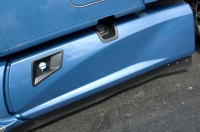 The flagship T680, when incorporating an aerodynamic Advantage package, is now available with a new partial fairing under the sleeper, better directing air out and around the rear wheels and onto trailers. An optional fuel fill point under the sleeper allows fuel tanks to be moved forward, too, further enhancing aerodynamics by reducing trailer gaps and wheelbases.
The flagship T680, when incorporating an aerodynamic Advantage package, is now available with a new partial fairing under the sleeper, better directing air out and around the rear wheels and onto trailers. An optional fuel fill point under the sleeper allows fuel tanks to be moved forward, too, further enhancing aerodynamics by reducing trailer gaps and wheelbases.
But that’s not the only fuel-saving enhancement on the truck that includes the MX-13 engine, automated Eaton Fuller Advantage transmission, and fuel-efficient drive axles. There’s also the option to include Predictive Cruise Control, which combines maps and GPS to decide if a truck should coast over the crest of a hill, harnessing the power of gravity to keep things on the move.
“The growth of Automated Manual Transmissions has been significant for Kenworth,” added Kurt Swihart, marketing director, when briefing industry media. A few years ago, barely a quarter of T680s were delivered with the self-shifting designs. This year, close to 70% were equipped that way. “A lot of younger drivers today are not familiar with manual transmissions and prefer to be able to drive an automated transmission,” he said.
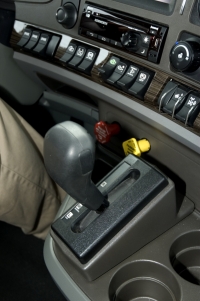 There is more automation to come. The Allison TC10 automatic transmission will be available sometime in 2017, and he expects several markets to embrace it. “I think the TC10 will be attractive to Pickup and Delivery types of applications – applications where there is a lot of braking and acceleration,” Swihart said. Just don’t expect Kenworth to adopt the ZF transmissions now used by their European counterparts who equip DAF trucks. “The Eaton partnership is very strong.”
There is more automation to come. The Allison TC10 automatic transmission will be available sometime in 2017, and he expects several markets to embrace it. “I think the TC10 will be attractive to Pickup and Delivery types of applications – applications where there is a lot of braking and acceleration,” Swihart said. Just don’t expect Kenworth to adopt the ZF transmissions now used by their European counterparts who equip DAF trucks. “The Eaton partnership is very strong.”
Technology is making its presence known in other ways as well.
Last month came the addition of an engine oil temperature monitor, ideal for those in cold climes who are concerned about issues like fuel gelling. Trucks with the auto-start-stop feature will even start without drivers inside if the temperature drops to sub-freezing conditions, which can be defined by fleets themselves.
Meanwhile, the Bendix Wingman Fusion – which draws on a camera and radar – is now in production, offering adaptive cruise controls and lane departure warnings. Follow someone too close, and the alarm begins to sound. Unlike previous generations, this system can also detect stationary objects. About 30% of all T680s are already spec’d with Bendix Wingman, and Kenworth expects the share to grow.
Sleep tight, haul light
One of the latest options to begin production is the 40-inch sleeper for the T680 and T880. This promises some extra comfort while still shedding about 260 pounds when compared to the 52-inch regional sleeper. When coupled with the T880 it offers a match for petroleum haulers or towing operations that use straight trucks, as well as businesses that need the added space to haul lowboys.
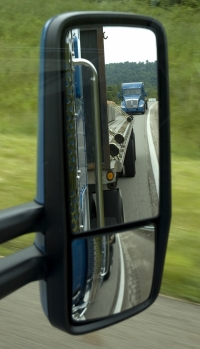 Compared to the 38-inch AeroCab sleeper, there is an extra 22 cubic feet of storage space, even though the 87-inch roof is six inches lower than its counterpart. Other features include a 24×75-inch liftable bunk and cell phone cubby. Vocational customers will also appreciate hooks that are designed to hold hard hats and coats, and two standard toolbox doors. Both the Diamond VIT and Vantage interiors are available.
Compared to the 38-inch AeroCab sleeper, there is an extra 22 cubic feet of storage space, even though the 87-inch roof is six inches lower than its counterpart. Other features include a 24×75-inch liftable bunk and cell phone cubby. Vocational customers will also appreciate hooks that are designed to hold hard hats and coats, and two standard toolbox doors. Both the Diamond VIT and Vantage interiors are available.
Views around the truck can be enhanced with 19×36-inch stationary or sliding windows on the back of the sleeper, helpful when manoeuvering in tight locations, and those can be combined with a pair of 19×12-inch outboard windows. Still other options include extreme-temperature insulation, LED marker lights, premium speakers, side extenders, and stainless steel sun visors.
The 76-inch mid-roof sleeper, launched last September, rounds out a lineup that includes a 76-inch high-roof used by most linehaul fleets, and the 52-inch mid-roof, high-roof, and day cab.
“That mid-roof option is a great option for many flatbed and tanker customers,” Swihart said, referring to how fuel economy can improve 5% when pairing a 76-inch mid-roof sleeper and a trailer or tanker that has a lower height. Running with a high-roof sleeper, after all, can create unnecessary drag against the upper part of the sleeper. “It acts as kind of a parachute in a way, by pulling the tractor back with the additional drag,” he explained.
The power
Then there’s the matter of big power in a smaller package.
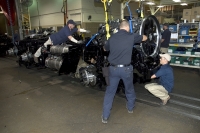 The Paccar MX-11 engine, designed with weight-sensitive applications in mind, is expected by Kenworth to be a popular seller. That new power plant offers up to 430 hp and 1,550 lb ft of torque, and is available in the T880, T680, T800 with FEPTO (Front Engine Power Take Off), and W900S. Most important, it is about 400 pounds lighter than comparable 13-liter engines and almost 100 pounds lighter than 11-liter counterparts.
The Paccar MX-11 engine, designed with weight-sensitive applications in mind, is expected by Kenworth to be a popular seller. That new power plant offers up to 430 hp and 1,550 lb ft of torque, and is available in the T880, T680, T800 with FEPTO (Front Engine Power Take Off), and W900S. Most important, it is about 400 pounds lighter than comparable 13-liter engines and almost 100 pounds lighter than 11-liter counterparts.
The six-cylinder, 24-valve design with double overhead camshafts injects fuel through a high-pressure common rail. The company says a graphite iron engine block with vertical ribs also helps to maximize strength and reduce noise.
“It’s an ideal engine for redi-mix customers,” Swihart said. Dump applications are using it, too, when customers are looking to shed weight from the overall packages. “We will see an increasing level of interest in LTL applications, Pickup and Delivery, and regional haul.”
Market share
For municipal, dump and tanker fleets, Kenworth has unveiled a “Baby 8” model in the form of the T370, with a 46,000-pound rear suspension and an 18,000- or 20,000-pound front suspension. The market could be 10,000 trucks across North America, Swihart added.
 Kenworth’s K370 and K270 cabovers continue to grow in popularity among urban users as well, he said, referring to the models that feature decidedly automotive-like interior styling. “Trucking business is not necessarily their primary business,” Swihart said. “One of the elements behind our market share growth is the continued growth of the cabover in those markets.”
Kenworth’s K370 and K270 cabovers continue to grow in popularity among urban users as well, he said, referring to the models that feature decidedly automotive-like interior styling. “Trucking business is not necessarily their primary business,” Swihart said. “One of the elements behind our market share growth is the continued growth of the cabover in those markets.”
On the bigger side of the equation, the company’s vocational flagship in the form of the T880 now represents about 30% of sales. Combined with T800s – which has a narrower cab — and W900s, vocational units still account for 40% of Kenworth trucks.
Maintenance tech
Then there’s the matter of keeping the trucks rolling.
TruckTech+ systems – now standard on the MX-11 – can monitor exactly how well the engine runs. The systems are already featured in about 10,000 Class 8 trucks, and come with a two-year subscription under the two-year standard warranty or Kenworth extended warranties.
“That’s really the seed of a much broader connected truck platform,” Swihart said. “Right now it’s a one-way system where the truck is able to transmit information.” Over time? The messages could flow two ways. Tesla, for example, already offers over-the-air engine updates.
The TruckTech+ system emails guidance ranging from whether a driver should keep driving, have a fault addressed at the next service interval, head to a dealer, or pull over. When service is needed, the system maps the three closest repair facilities, and data is fed to fleet managers through a web portal.
DEF storage
Body builders will also enjoy some added room thanks to another option.
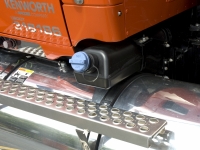 Diesel Exhaust Fluid tanks can now be removed from T680 and T880 frame rails, and replaced with a version that can be mounted above the fuel tank and under the cab. This means easier work for body installers when the tank is combined with an in-cab battery boxy, right-hand under-cab aftertreatment, or left-hand under-cab fuel tank.
Diesel Exhaust Fluid tanks can now be removed from T680 and T880 frame rails, and replaced with a version that can be mounted above the fuel tank and under the cab. This means easier work for body installers when the tank is combined with an in-cab battery boxy, right-hand under-cab aftertreatment, or left-hand under-cab fuel tank.
Space is not the only thing that is saved. The US 7.3-gallon tank is 25 pounds lighter than the version it replaces.
Glide and ride
Recent changes have also focused on adding strength.
The T880 is now available with Hendrickson Ultimaax severe-duty rubber suspensions. On the T880, those are available with axle ratings between 46,000 and 52,000 pounds, axle spacings of 54-60 inches, and an 11-inch ride height. That’s a match for refuse, sand and gravel, cranes, platform trucks, and logging operations, among others.
Service life is said to be improved thanks to bar end bushings, a progressive load spring design and rugged axle connection. Replacements are eased with a progressive load spring design, while the axle connection is meant to reduce re-bushing needs. The suspension’s integrated walking beam also uses a central pivot point to keep tires in contact with the road, and the flat bottom increases ground clearance and offers a 17.5-inch diagonal wheel articulation.
The T370, meanwhile, now comes with 16,000-20,000-pound non-drive front steer axles and 44,000-46,000-pound tandem-drive rear axles. The MFS20 front axles and MT-44 and RT-46 rears can be spec’d with Paccar’s PX-9 engine rated up to 350 hp and 1,150 lb ft of torque. The offerings at the upper end of the spectrum open the truck up to be used by dump, fuel and mixing operations, among others.
The MFS20 front axles, meanwhile, come with 16,000-, 18,000-, and 20,000-pound Gross Axle Weight Ratings, and feature a front frame reinforced with cross braces, bolted cross members, and 10-3/4-inch frame rails or 10-5/8-inch frame rails with bolted cross members. The lighter engine and higher-capacity front axle combination are rounded out with iron hubs, dual-power steering gears, and a power steering cooler.
The 44,000-pound MT-44 rear axle and its 46,000-pound RT-46 counterpart are both designed to run 800,000 kilometers between lube changes. The T370 is also available with other rear suspensions rated up to 46,000-pounds.
Have your say
This is a moderated forum. Comments will no longer be published unless they are accompanied by a first and last name and a verifiable email address. (Today's Trucking will not publish or share the email address.) Profane language and content deemed to be libelous, racist, or threatening in nature will not be published under any circumstances.